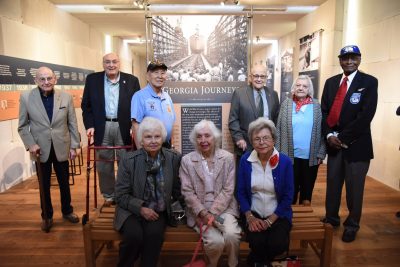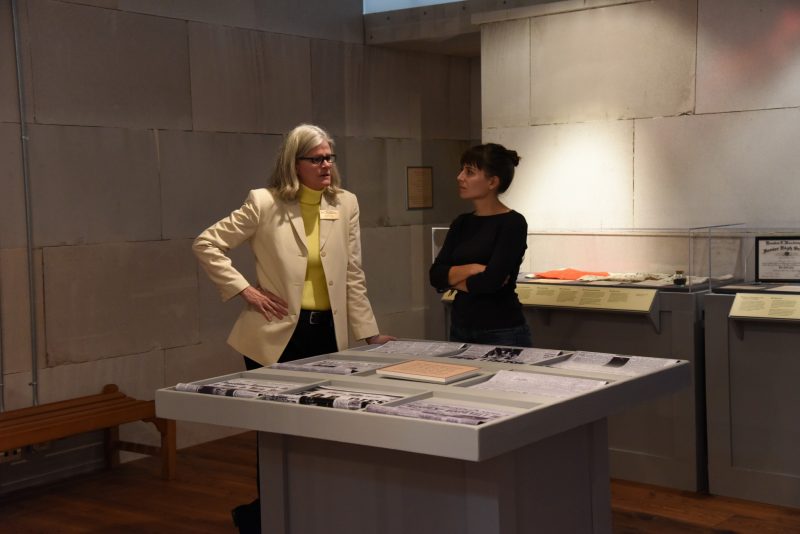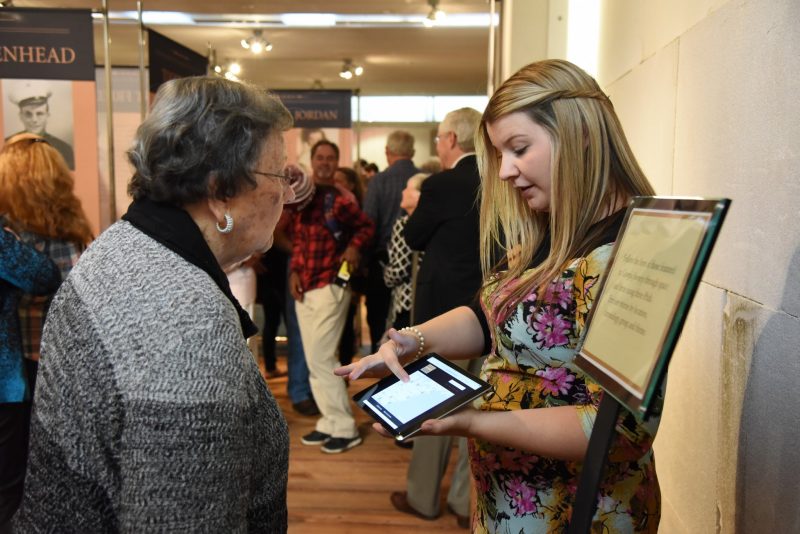Project Showcase: Georgia Journeys
01 November 2016 – Adina Langer

Individuals featured in “Georgia Journeys” posing at the exhibit opening. Photo credit: Kate Daly
Last Sunday, October 23, 2016, marked the opening of Georgia Journeys: Legacies of World War II , a new permanent exhibit at the Museum of History and Holocaust Education at Kennesaw State University. The opening reception brought together educators and the interested public with nine of the twelve veterans, home front workers, and Holocaust survivors featured in the exhibit.
After working on the exhibit for the past year, it was such a joy to watch the featured individuals enjoying their “celebrity status,” standing in front of their biographical panels while visitors asked them questions and requested photographs. These are all special people and they are also ordinary people. The exhibit is built on their stories, which they shared with the museum through its Legacy Series oral history program.
Although the Legacy Series and its participants provided the material inspiration for the exhibit, we were also motivated by two big ideas, one about the content and another related to the experience. Finding a narrative anchor for this exhibit was challenging, in part because of the diversity of its human subject matter. Featured individuals’ stories were all tied to both World War II and Georgia, but the stories did not connect with one another. Rooting the exhibit in place led us to consider how World War II was a catalyst for change in Georgia. Even more interesting is how the experience of the war illustrated a fundamental characteristic of history: places and events are affected by individual people, just as people are affected by the places and events they encounter. Depending on your perspective, those effects can seem more or less significant, but change cannot happen without them. This idea led us to include President Franklin Delano Roosevelt in a mini-exhibit as the thirteenth “Georgia journey.”

Public historians Jennifer Dickey and Julia Brock stand beside artifact cases and a vinyl newspaper “touch table” at the opening of Georgia Journeys. Photo credit: Kate Daly
Even as we wrestled with the central ideas in the exhibit, we built it with a diverse audience in mind. We wanted the experience of the exhibit to appeal to different kinds of learners, so we embraced content repetition delivered through a variety of access points. The exhibit includes, among other elements, people-focused text, images and artifacts for linguistic, inter- and intrapersonal learners, timelines and maps for spatial and mathematical learners, excerpts from radio broadcasts and 1940s public service advertisements for auditory learners, and scrapbooks and newspaper reproductions for kinesthetic learners. These exhibit elements provide a built-in set of stations to create a new and unique structure for school group tours.

Educator Andrea Miskewicz demonstrates the “Georgia Journeys” digital exhibit on an iPad during the opening reception. Photo credit: Kate Daly
We are also proud of our Georgia Journeys digital exhibit which enables visitors to follow the stories of those featured in the exhibit through space and time. This website, built on Omeka running the Curatescape theme, illustrates an especially important point: you can’t understand World War II without understanding the Holocaust, and you can’t understand the Holocaust without understanding World War II.
We are hopeful that our various exhibit elements and themes will come together to inspire teachers, students, and everyone interested in World War II to seek out new opportunities to meet history face-to-face.
~ Adina Langer is the curator of the Museum of History and Holocaust Education at Kennesaw State University. You can find her on the web at www.artiflection.com and follow her on Twitter @artiflection.



